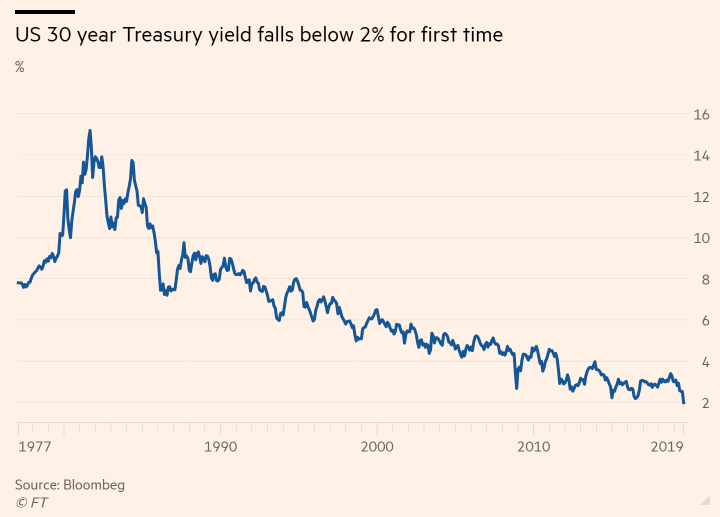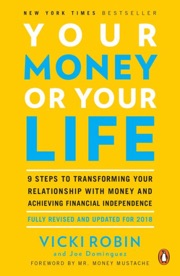 Last week, the yield on the 30-year US Treasury bond dropped below 2% for the first time in history. Many other articles will try to explain why this happened, and what this means for the future. Not me. I have no clue what’s coming and don’t think anyone else does either. Here’s the historical yield chart via Financial Times:
Last week, the yield on the 30-year US Treasury bond dropped below 2% for the first time in history. Many other articles will try to explain why this happened, and what this means for the future. Not me. I have no clue what’s coming and don’t think anyone else does either. Here’s the historical yield chart via Financial Times:

Reader skg recently shared that the original 1992 edition of Your Money or Your Life by Vicki Robin and Joe Dominguez is now available online (partially to promote the new 2018 edition).
 I rate this book a “must read” for those interested in a philosophical inspiration behind financial independence. However, the specific investing advice inside was to put all of your money into a ladder of 30-year US treasury bonds. Here an excerpt from the book on what they were looking for:
I rate this book a “must read” for those interested in a philosophical inspiration behind financial independence. However, the specific investing advice inside was to put all of your money into a ladder of 30-year US treasury bonds. Here an excerpt from the book on what they were looking for:
1. Your capital must produce income.
2. Your capital must be absolutely safe.
3. Your capital must be in a totally liquid investment. You must be able to convert it into cash at a moment’s notice, to handle emergencies.
4. Your capital must not be diminished at the time of investment by unnecessary commissions, “loads,” “promotional” or “distribution” expenses (often called “12b- 1 fees”), management fees or expense fees.
5. Your income must be absolutely safe.
6. Your income must not fluctuate. You must know exactly what your income will be next month, next year and twenty years from now.
7. Your income must be payable to you, in cash, at regular intervals; it must not be accrued, deferred, automatically reinvested, etc. You want complete control.
8. Your income must not be diminished by charges, management fees, redemption fees, etc.
9. The investment must produce this regular, fixed, known income without any further involvement or expense on your part. It must not require maintenance, management, geographic presence or attention due to “acts of God.”
That sounds pretty good, right? But then you have to remember that Joe retired about 1970 and this book was written about 1990. Look again at rates from 1970-1990 in the chart above. Another excerpt:
For most of this century, up until the late 1960s, interest rates were under 5 percent. Since their peak in 1981, long-term interest rates have been wending their way back down toward their historical norms. You did not need to catch the bond market at those abnormal highs in order to reach FI. Even at 5 or 6 percent, this program will work.
In 1969, when Joe reached FI, his capital was invested in bonds with interest averaging 6.85 percent and maturities extending into the 1990s. Through a few judicious bond swaps, and with no income other than the income from the bonds, his portfolio now has an average yield of 9.85 percent and maturities extending to the year 2007 on average.
Note that bolded quote “Even at 5 or 6 percent, this program will work”. Well, what about 2%? It probably wasn’t even on his radar as a possibility at that time. I’m sure something else will happen in the next 30 years that isn’t on my radar now.
Even buying the safest bonds in the world and locking them in for the longest period possible is not free from risk. Long-term bonds can still be one component of a diversified portfolio, assuming you understand when it will do well and when it won’t. However, it is important to realize that owning 100% long-term bonds at 2% leaves you very vulnerable to future inflation.
This is only a small part of the book, and there is additional discussion about being flexible in your own spending:
Your choices, attitudes, beliefs, habits, tastes, fears and desires have the ultimate effect on your bottom line.
Bottom line. Every time I see the line “for the first time in history”, I am reminded that no portfolio is 100% safe. We can look back at history as guide, but also accept its limitations. Even buying the safest bonds in the world and locking them in for the longest period possible is not free from risk. Preparing for retirement isn’t just about your investment portfolio, but also having adequte insurance coverage and your ability to be flexible in both spending and earning.
 The Best Credit Card Bonus Offers – 2025
The Best Credit Card Bonus Offers – 2025 Big List of Free Stocks from Brokerage Apps
Big List of Free Stocks from Brokerage Apps Best Interest Rates on Cash - 2025
Best Interest Rates on Cash - 2025 Free Credit Scores x 3 + Free Credit Monitoring
Free Credit Scores x 3 + Free Credit Monitoring Best No Fee 0% APR Balance Transfer Offers
Best No Fee 0% APR Balance Transfer Offers Little-Known Cellular Data Plans That Can Save Big Money
Little-Known Cellular Data Plans That Can Save Big Money How To Haggle Your Cable or Direct TV Bill
How To Haggle Your Cable or Direct TV Bill Big List of Free Consumer Data Reports (Credit, Rent, Work)
Big List of Free Consumer Data Reports (Credit, Rent, Work)
If he locked in 5% 30 or 20 years ago and did not sell till maturity, the yield changes during the time won’t affect the outcome.
Right. I think the bigger point here is that those types of yields aren’t available today either for new retirees or people who have been retired for some time whose bonds are maturing and who need to roll them into new bonds.
One annoyance with these sorts of articles: they always claim the yield curve inverted and that this suggests a recession may be coming, but they never mention that, historically, the best predictor of recessions is an inversion of the 2 year vs. 10 year treasury bond rates — which, notably, has not inverted recently (even for a single day)!
I suspect the authors know better, but it’s easier to attract eyeballs to their advertisements by dangling the possibility of a recession in front of their readers…
It hasn’t closed negative but it dipped slightly negative on August 14th before going back to positive. It’s around 3 basis points today. Whether the spread reaches .01%, 0%, or goes negative by .01% or more (and whether it happens intra-day or closes there) is kind of semantics. The point is we are well within the ballpark of a significant recession indicator. In a normal economy the spread wouldn’t be this low.
Jonathan….if you want a MUST READ: Try Carmen Segarra’s – Noncompliant: A Lone Whistleblower Exposes the Giants of Wall Street. The book is focused on the total corruption and incompetence of the NY Fed and the Federal Reserve Board post 2008. As mass media’s talking heads and the clowns at the ECB take us down the road to recession and negative interest rates I think the answer to your question is that the Fed has two mandates. 1- Annihilate the middle class in America and set up the conditions that allow Wall Street to steal everything they haven’t stolen already. And 2- Starve senior citizens and retirees to death with another 10 years of zero percent interest rates. Nobody seems to even ask the question, why after 10 years of free money, deregulation and every other accommodation possible we are back where we started with cries for emergency monetary and fiscal stimulus. And you, I and all your readers will pay the price of not having that answer
Check out book by Jim Rickards “Aftermath” just released last month.
Crazy to think that yields are about to go negative… You could actually get a 10 year mortgage in Denmark for a <0% interest rate. Can you believe that??
Seems like everywhere in Europe as well as the US is heading in the same direction.
No single investment is safe fora long period of time, but at this point Gold seems to be a good investment for the crazy negative yielding environment we have right now… As yields go lower and central banks print money, gold should outperform.
Natural hedge against the crazy monetary policy we have these days.
It’s always great to get good money and investment advice. But the advice is all over the place, it can be very confusing. One guru wants you to do this, and the other guru wants you to do that. Sometimes it’s good to go with your gut.